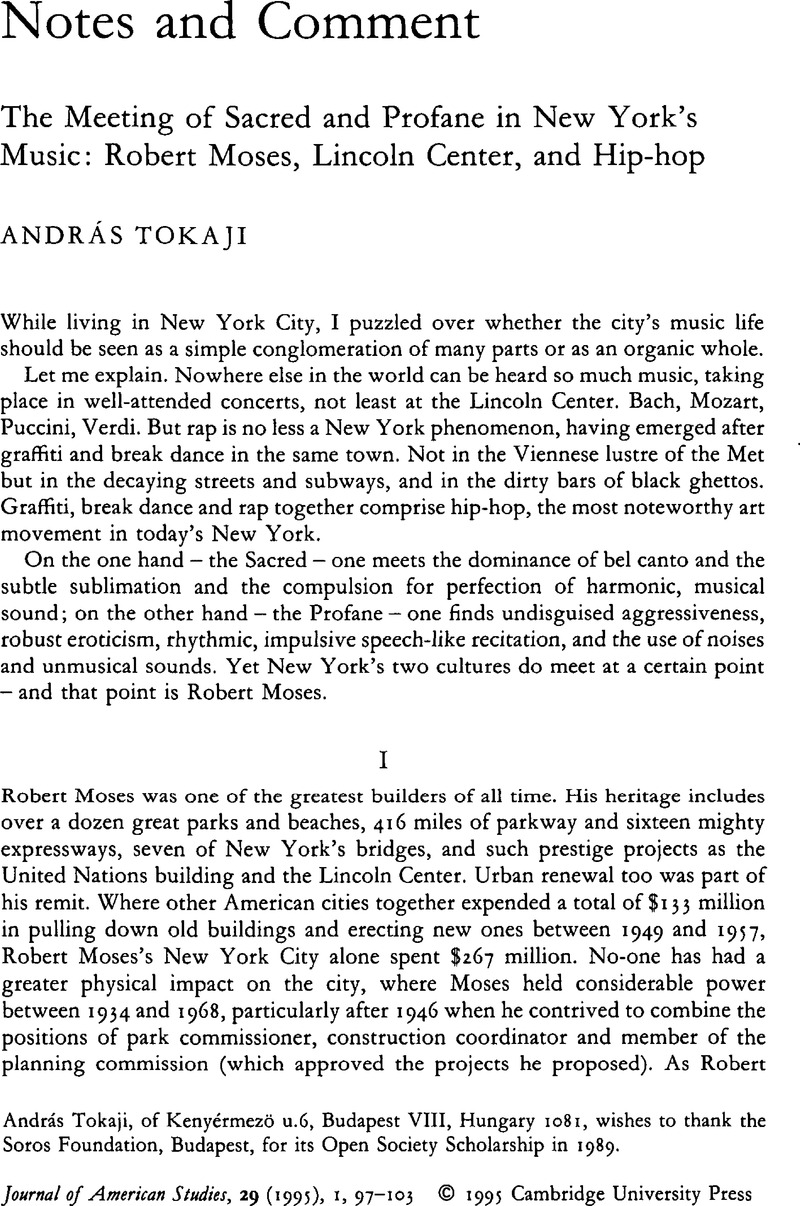Article contents
The Meeting of Sacred and Profane in New York's Music: Robert Moses, Lincoln Center, and Hip-hop
Published online by Cambridge University Press: 16 January 2009
Abstract

- Type
- Notes and Comment
- Information
- Copyright
- Copyright © Cambridge University Press 1995
References
1 Caro, Robert A., The Power Broker: Robert Moses and the Fall of New York (New York: Knopf, 1974), 5–12Google Scholar; see also Schwartz, Joel, The New York Approach: Robert Moses, Urban Liberals, and Redevelopment of the Inner City (Columbus: Ohio State University Press, 1993)Google Scholar.
2 Caro, 1013.
3 Hitchcock, H. Wiley and Sadie, Stanley, The New Grove Dictionary of American Music (London: Macmillan, 1986)Google Scholar.
4 Martorella, Rosanne T., The Sociology of Opera (South Hadley, MA: Bergin, 1982), 51Google Scholar.
5 Ibid., 60.
6 Schoenberg, Harold C., “Have Cultural Centers benefited the Arts?”, New York Times, 11 07 1983, section 2Google Scholar.
7 Lipman, Samuel, The House of Music — Art in an Era of Institutions (Boston: David R. Godine publisher, 1984), 142–43Google Scholar.
8 Kaplan, Max, “Sociology of the Musical Audience”, Musical Journal (01 1961), 60Google Scholar.
9 Tawa, Nicholas E., A Most Wondrous Babble: American Art Composers, Their Music, and the American Scene, 1950–1987 (Westport, CT: Greenwood, 1987), 195Google Scholar.
10 Caro, 849.
11 Ibid., 20.
12 Ibid., 1014.
13 Ibid., 20.
14 Hager, Steven, Hip Hop: The Illustrated Break Dancing, Rap Music and Graffiti (New York: St. Martin's Press, 1984), 1Google Scholar.
15 Caro, 877–78.
16 Berman, Marshall, All That Is Solid Melts Into Air (New York: Verso edn. 1983), 292–93Google Scholar.
17 Hager, 5.
18 Ibid., 10.
19 Ibid., 31–33.
20 Wepman, D., Newman, R. B. and Binderman, M. B., The Life: The Lore and Folk Poetry of the Black Hustler (Philadelphia: University of Pennsylvania Press, 1976), 1–15Google Scholar.
21 Abrahams, Roger D., Deep Down in the Jungle (Chicago: Aldine Publishing, 1970), 35Google Scholar.
22 I.e., whodunit, created originally by Kaufmann, Wolfe (Variety Magazine, New York)Google Scholar.
23 Elfman, Bradley, Breakdancing (New York: First Avon Printing, 1984)Google Scholar.
24 Music and lyrics by Stephen Sondheim, written and directed by James Lapine (first performance, San Diego, 1987).
- 1
- Cited by


